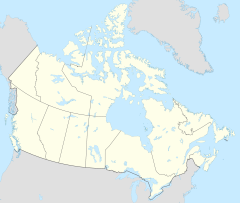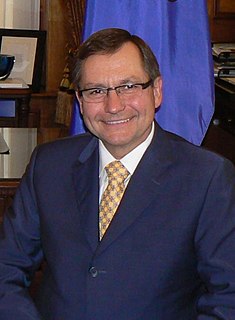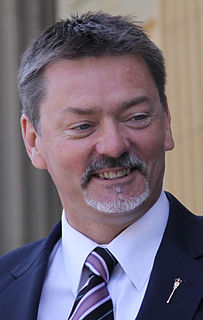History
The provincially-owned building was built by the federal government from 1955 until 1958. It was first proposed in the 1930s to host the Government of Canada's federal offices in Western Canada. The architectural design was submitted in 1939, but construction was delayed by World War II and by changes in governments and priorities. In 1955, when construction began, the size of the building was doubled but the original Art Deco 1930s architecture designed by a prominent, local architect, remained largely unchanged. [3] :81 The building was officially opened by then Prime Minister John Diefenbaker on March 8, 1958. Federal staff worked from this building for the next thirty years.
With the completion of Canada Place building in downtown Edmonton in 1988, federal staff were relocated and the Federal Building was vacant for over a decade. [1] In anticipation of federal staff relocation, the Government of Alberta had purchased the building for $20.5 million in 1983, with the intention of housing provincial government offices. [1] In 2010, the Alberta government announced that the Federal Building would house offices for both the provincial and federal governments, as well as recreational space for the general public. [1]
The Edmonton Federal Building restoration project, which was overseen by the Edmonton-based Kasian Architect firm, [4] took place over a period of six years from 2009 to 2015 under then Premier Ed Stelmach. [5] Work began in 2009 and it was expected that it would be completed by 2011 or 2012. [6] The project including the expansion of the plaza and year-round recreational spaces for the general public on the grounds. [4] Stelmach submitted his resignation letter as premier in June and stepped down in October 2011. Alison Redford, was elected as the leader of the Conservative party and was sworn in as premier in October 2011. [7] [8]
During the renovations, most MLAs had offices in the Alberta Legislature Annex Building, [9] a 67-year old 12-storey office building that is in a state of disrepair and it set to be demolished in 2021. [10] Beginning in February 2015, 600 members of the legislature and other government staff occupied offices in the building. The Capital Plaza with its fountains and green spaces opened in the summer of 2015, along with other public spaces in the building including a visitor centre, exhibition spaces, and an 80-seat theatre. [1]
Design
The original ten-storey building, which has a steel frame, was made with Tyndall stone from Manitoba and granite. [1] [5] The interior of the building was finished with six different kinds of marble some of which came from England and France. [5] It was considered to be one of the most significant modern buildings in Edmonton and a unique example of Art Deco architecture. [1]
The Federal Building was originally designed in 1939, by a prominent local architect George Heath MacDonald, but its construction was delayed until long after World War II. [3] :81 In a 1987 book about architecture in Alberta, the building that finally opened in 1958, was described as "rather tired and instantly dated", designed by an architect heading into retirement based on plans that were almost twenty years old. In the 1930s, the building was part of a make-work project. The original design was inspired by architecture of the 1930s, such as the Empire State Building built in 1930-1931, and the 1930 Chrysler Building, both located in New York City. In the 1950s, MacDonald "only slightly updated" the design which meant that the federal building was "one of the last Art Deco interiors built anywhere." [3] :81 The federal building lobby is "inset with marble and nickel-plated metal works to create one of the liveliest Art Deco interiors in Alberta". [3] :81 The building was the last major project of MacDonald's "long and prolific career" starting as a draftsman in Nova Scotia, earning his architecture degree at McGill University, and working for H. A. Magoon architectural firm in Edmonton in 1911. [3]
Rejuvenation and construction of a new public plaza (2009 - 2015)
In 2006, during the premiership of Ralph Klein, then infrastructure minister Lyle Oberg announced the renovation of the building with an "unspecified budget". [5] When Oberg left office, the plans did not proceed. In 2008, then Premier Ed Stelmach announced the $356-million redevelopment plans, which included an underground parking lot for the 650 future tenants. [5] In 2009, the Stelmach administration started the rejuvenation and construction project. It was expected that it would be completed by 2011 or 2012. [6] Ray Danyluk, who was Stelmach's Minister of Infrastructure in 2010, said that the "$356 million Federal Building and Centennial Plaza (now known as Capital Plaza) renovation and redevelopment project" that started in 2009, blended the future with Alberta's history. It would preserve the "history and beauty of an architectural landmark", and—along with the creation of the Centennial Plaza—would transform the legislature grounds into a year-round appealing public space for all Albertans. [11] :14 Because of the economic climate in 2009 there were considerable cost savings on the Federal Building redevelopment project in 2010. [11] :14
Danyluk said in the 2010 Department of Infrastructure annual report, that was reviewed favourably by the Auditor General, Merwan N. Saher, that the Stelmach government was committed to adopting Leadership in Energy and Environmental Design (LEED) standards in construction projects. [11] Following the renovations, the federal building was LEED Gold certified. [1]
Following the resignation of Premier Stelmach in October 2011, during the premiership of Alison Redford there was a succession of infrastructure ministers—Jeff Johnson (2011 - 2012), Wayne Drysdale (2012 - 2013), and Ric McIver (2013-). The project was the subject of an investigation and a 2014 Special Duty Report by the Auditor General of Alberta. [12] By the time she left office in March 2014, under pressure from an "escalating spending scandal", [13] the renovation project had been "dogged by cost overruns and controversy." [9] Cost overruns included the removal of large quantities of asbestos, building reinforcements, as well as "new steel floor supports". [5]
In a January 2015 Edmonton Journal article, now Senator Paula Simons described some of the additions and changes, which included a private caucus room on the tenth floor that cost $84,265, a $40,000 cabinet table, and a "new $602,000 main staircase". [5]
The new foyer was a glass atrium pavilion with a living wall and a living roof. A granite plaza which included water fountains, green spaces and gardens—now known as Capital Plaza—was built to extend the Legislature grounds to 99 Avenue and to increase public spaces at the grounds. [14] The renovation added additional public elements such as the 80-seat theatre and a climate-controlled art gallery space. [5]
By the summer of 2014, the price of crude oil—including Alberta's benchmark Western Canadian Select—collapsed to near ten-year low prices, caused in part by a global oil glut. [15] [16] [17] [18] Against the backdrop of a dramatic decrease in oil revenues at a dramatic low, the cost of renovations had increased to $403 million. By the time Premier Jim Prentice took office in September 15, 2014, the renovations were almost finished. While Manmeet Bhullar was Infrastructure Minister, during the Prentice administration—from the fall of 2014 until the 2015 dissolution of the Legislature—the project was completed.
The Premier's suite
When Premier Alison Redford was sworn in on October 2011, following Stelmach's resignation, Jeff Johnson served as Redford's first Minister of Infrastructure from October 2011 until the spring of 2012. [19] Following the 2012 Alberta general election then-Premier Redford named Wayne Drysdale as Minister of Infrastructure. In December 2013, during a cabinet reshuffle, Ric McIver replaced him. [20]
In May 2012, shortly after winning the election, the Redford became involved in the provincially-owned federal building redevelopment plan for the tenth and eleventh floors, according to the August 7, 2014 Special Duty Report by the Auditor General of Alberta. [12] :6,43 [21] Under Redford's new administration significant changes were made in the use of space on the eleventh floor, from "open hosting for government caucus to a premier's suite" which included changing the original design and incurring additional costs. [12] The Premier's office contacted the Kasian Architecture firm directly to discuss the provision of "residential functions" on the eleventh floor, [21] which included adding two side-by-side bedrooms with showers. [12] :6,43 Paula Simons described the addition as a $2.76 million "ultra-modern glass-walled" penthouse with its own dedicated elevator. The "sky palace", as it was dubbed, was intended as Redford's personal retreat. [22] [23] Redford resigned in March 2014 just before the "sky palace" was made public, under pressure from an "escalating spending scandal", [13] and was replaced by Dave Hancock.
Shortly after CBC broke the story about the "sky palace" in March 2014, Ric McIver, who had served as Redford's Infrastructure Minister since December 2013, said the plans for a residential suite were cancelled after he took over the ministry. [2] He said that he had changed "residential construction" on the premier's suite to "meeting room construction," effectively "killing" the "sky palace" in mid-January, 2014. [21] However, an August 7, 2014, Auditor General report revealed that the "penthouse ordered by Redford [had] continued to be built with the same layout and finishing she originally ordered" as of August 2014. [21] [13] The City of Edmonton confirmed in 2014 that the building permit allowed the eleventh floor space to be used as residential. [12] :43 The Department of Infrastructure continued to build the floor plans for the eleventh floor suite based on the plans approved in 2012. The only change was related to the "planned use of space". It was to be used as a "meeting space rather than a residential space". [12] :6 By 2015, when the project was completed, Redford's original plans for the eleventh floor—which had included "bedrooms, bathrooms, a dining room, lounge area, room-by-room temperature controls, a fireplace, a powder room and a butler’s pantry"—had been revised. The space was transformed into meeting rooms and a conference hall. [13]
The living wall
Nedlaw Living Walls, the company that built the living wall in the federal building's atrium lobby in 2014—a multi-level, 2,400 square foot plant display"—which served as a focal point for visitors and as a biofilter for the building's heating, ventilation, and air conditioning (HVAC) system, won the 2016 North American Cities Alive Conference's Interior Green Wall Award of Excellence for the living wall in the federal building. [24] The green wall, and the renovation project in general, was built under the direction of the architectural firm, Kasian Architects. The technology behind the green wall was the result of research on methods for recycling air in space stations, funded by space agencies in both Canada and Europe, and undertaken at the University of Guelph's Controlled Environments Systems research facility led by a team led by Alan Darlington. [25] It integrates both bio-filtration technology—which breaks down "air pollutants into benign components" and phytoremediation, through which plants "restore a contaminated environment." [25] When he accepted the 2016 North American Cities Alive Conference's Interior Green Wall Award of Excellence, Darlington said that, this "biofilter actively removes pollutants from the air, generation over 1,500 cfm (700 litres per second) of virtual fresh air...That's enough 'fresh' air to supply two thirds of the needs of over 150 people. And this virtual fresh air is generated using up to 90 per cent less energy than conventional air treatment systems." [24]
In September 2020, Prasad Panda, the Minister of Infrastructure during the Premiership of Jason Kenney said that the annual maintenance costs of the living wall amounted to $70,000. Panda announced that the living wall would be removed and "replaced with sculptures as part of an ongoing upgrade of the heating, ventilation and air-conditioning system." [26] By the end of November, ahead of schedule, the wall had been dismantled because of a bug infestation. [27]













